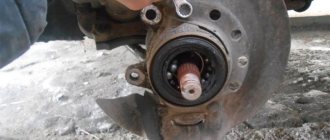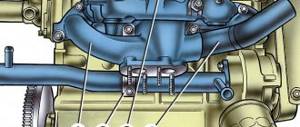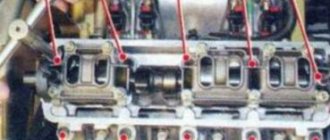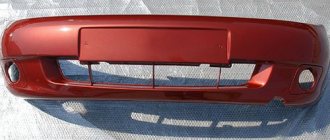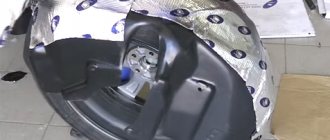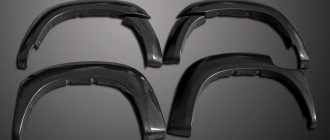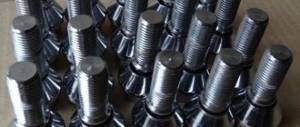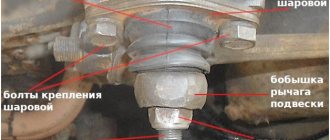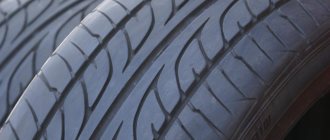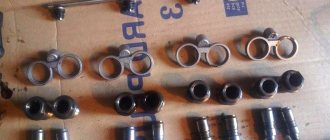Tables of wheel bolt patterns and selection by car brands
Many motorists from time to time have to deal with a difficult task - loose wheel rims, which directly affects the safety of movement. Therefore, car enthusiasts should pay utmost attention to wheel bolt patterns. If the correct installation parameters relative to the axle are not observed, the wheel disk is not securely fixed enough, and the optimal tightening torque value is not achieved.
The main criteria that you should focus on when performing work are the number of bolts and the diameter of the circumference of the seats. Several ways to determine the last parameter are popular among drivers. However, not all methods can be called effective.
The simplest and most understandable method is the following:
- First you need to set the distance between the walls of the holes using a caliper.
- Then you need to add the diameter of the fixation hole to a certain value.
The resulting size will determine the distance between adjacent holes.
A large number of motorists adjust the bolt pattern to new wheels, the diameter of which is slightly larger than the original version. When installing such products, centering rings are used.
The main task of the car owner is to choose rims of optimal weight and strength. The last factor plays a decisive role, since the wheels constantly take on serious loads and impacts. Also, do not neglect balancing, which will avoid discs from beating while driving.
The bolt pattern is carried out in strict compliance with three main parameters:
- PCD – circle diameter;
- ET – disc offset;
- DIA is the diameter of the central hole.
For each car model, wheel bolts are selected based on a unique combination of three indicators. When selecting specific disks and bolts, you must rely on the data in the table. Example values:
Domestic cars
Audi
BMW
Ford
Hyundai
Example of a bolt pattern:
How to tighten a hub nut without a torque wrench
Many car enthusiasts, when repairing their car, consider it not advisable to purchase torque wrenches or other specialized devices (pullers, etc.). There is a good way to tighten the fastener to the required torque without using a torque gauge. The following devices will be required: 1. Ratchet with a head for a lock nut; 2. Pipe for extending the ratchet to create the required “shoulder”; 3. Roulette; 4. Marker; 5. A weight that can be hung on the “shoulder” (for example, a 32 kg weight).
The essence of the method is to calculate the moment using the formula from elementary physics classes:
P is the applied force, N; l is the distance from the hub to the point of application of force - the “shoulder”, m. The ready-made formula for our case will be as follows:
P1 = (M2•100)/(M1•10) ( • 10 (or • 9.8) - translated into Newtons), where
P1 is the distance at which the sinker is attached to the “shoulder” relative to the torsion point, cm; M1—cargo mass, kg; M2—required torque, N•m.
Calculation example for a Ford Focus 2 car
P1 = (M2•100)/(M1•10) (•10 (or •9.8) = (45•100)/(32•10) = 4500/320 = 14 cm. Conclusion: to ensure a tightening torque of 45 N•m will require a sinker weighing 32 kg, located on the pipe at a distance of 14 cm.
- First screw on the locknut and tighten it slightly.
- We mark a distance of 14 cm, where the rod should hang;
- We hold the ratchet with one hand and hang the sinker with the other, thereby tightening the fastening;
- The operation continues until the fasteners stop tightening under weight, which means that we have achieved the required force. Accuracy +/- 5%.
Wheel bolts with eccentric
Special attention should be paid to the bolts themselves. The diameter of bolts for passenger cars is from 12 to 14 mm.
The bolt head is made in various ways. The most common options are moldings for a wrench or head, hexagon, and also with a secret. Each option is characterized by a high level of reliability.
Security bolts can be equipped with special plugs. But the main difference between these hardware is that they cannot be unscrewed without a unique key. Specialized bolts are sold in a set with a key, the geometry of which is ideal for only one type of fastener. This technology effectively protects wheel rims from theft. However, there are also disadvantages - if you lose the key, you will have to turn to service station specialists for help. Only experienced craftsmen will be able to carefully drill out hardware.
Wheel lubrication
There are several problems that car enthusiasts face. First of all, it's rust. Over time, corrosion damages not only the threads, but also the cap itself. However, this problem does not apply to those hardware that are coated with an anti-corrosion compound from the factory.
Quite often the bolts stick. This phenomenon makes it difficult to use an electric impact wrench. It is difficult to unscrew the hardware manually. When the head of a bolt breaks off when unscrewing, many vehicle owners report insufficient lubrication. But there is debate regarding the advisability of using lubricants for the threaded part of wheel bolts. Some car owners claim that lubricating compounds can significantly extend the life of bolts. Others are opposed to the use of various lubricants for wheel bolts, because they believe that the oil can contribute to the loosening of the hardware while the car is moving.
Wheel bolts are treated with lubricants to avoid corrosion and sticking. The lubricant layer prevents the negative influence of water and air, since the result of such interaction can be souring and excessive fixation of the bolts in the hub.
But a large amount of lubricant reduces the level of friction. It is also possible that the fasteners may loosen as a result of the use of a lubricant. This is the main reason why you should not lubricate a wheel bolt. As a result of constant exposure to vibration, the hardware becomes unscrewed, and the loss of a wheel while moving becomes inevitable.
In practice, such situations rarely occur. For example, the cause of excessive fixation of fasteners is overtightening during previous wheel maintenance. Drivers can independently extend the hardware to the level where dismantling with improvised means becomes impossible. Specialists at service stations also make a similar mistake. When using wheel bolt impact wrenches, they do not consider the capabilities of pneumatic devices.
Lubrication is not the main reason for hardware loosening. The conical part of the bolt is designed to perform several functions at once:
- The wheel is centered.
- The disk is tightly fixed.
- During installation, the cone creates a wedge that prevents spontaneous unscrewing while moving.
Many experts say that it is possible to use lubricant. This is an optional procedure, however, the composition can protect the threads from corrosion.
Wheel Bolt Tightening Tools
The basic manual included with each vehicle clearly states wheel bolt torque values. Therefore, before proceeding with dismantling, you should carefully study the procedure for reinstalling hardware.
The tightening of wheel bolts is a key indicator of reliable wheel operation. Therefore, experts strongly recommend that you only refer to the instructions for a specific car model for information. Any information taken from the Internet should be used as a guide only.
Pay attention to the specified tightening torque relative to the specific modification of the car. In this case, all details are taken into account, right down to the engine model.
The main condition for high-quality installation is the availability of reliable devices. One such tool is a torque wrench. A characteristic feature of this key is its wide range of application possibilities.
If you choose the right torque wrench, even an untrained person will be able to correctly install wheel bolts and nuts in a garage environment. There are three main types of keys:
- switch;
- clicky;
- electronic.
The purpose of all three types is to set the optimal tightening torque. Using simple manipulations with the scale, the required level of effort is set. The simplest one is the arrow key. When tightening, the scale indicates the torque, and the driver himself adjusts the force. The advantage of these keys is their low cost and durability. Thanks to their simple design, the keys last for many years.
Click and electronic keys are considered more advanced. With their help, you can set the desired value, which will be controlled automatically. All the owner needs to do is to pull the device with a certain force until the mechanism cuts off.
Pneumatic versions of impact wrenches are also widespread. Specialized devices are used mainly at service stations. In isolated cases, drivers purchase pneumatic devices for themselves. The pneumatic tool is equipped with a function for setting the optimal tightening torque. These devices can be used to mount any hardware, for example, Febi wheel bolts.
Many car enthusiasts resort to a simple method of tightening bolts - with simple wrenches. However, this method cannot be called sufficiently reliable. The reason is the possibility of insufficient tightening. The result of an unprofessional approach will be vibration of the steering wheel. This effect is especially noticeable at high speed, which poses a danger to the driver and passengers.
Weak tightening of the rear axle hardware will lead to premature wear of not only the tires, but also most of the chassis parts. Due to non-compliance with the recommended values, the bearings and the wheel itself become faulty.
Torque Wrench Bolt Torque Chart
Recently, many car owners have been installing lightweight alloy wheel nuts made of aluminum. They look stylish.
A special table of the tightening force of these wheel bolts depending on the manufacturer and model will allow you to determine all these parameters.
The longer I blog, the more I begin to pay attention to things that at first glance would seem not so important, and which many neglect. But a car is a complex mechanism, where everything is designed to strictly follow instructions. And if you want to be 100% confident in your iron horse and not be afraid that your wheel will fall off for no reason on the road, then read this post.
As the season approaches, I begin to pay more and more attention to my car, its technical equipment and maintenance. I read, look for videos on YouTube. And just the other day, I came across a video in which a man talks about how important the correct tightening of wheel nuts is. Unfortunately, I can’t find the video anymore, but I’ll try to convey the essence of it.
Read also: Repair of chain sharpening machines
The bottom line is that each manufacturer has its own tightening torque for the wheel nuts, i.e. the calculated force that must be applied to tighten the wheel nuts without stripping the threads. Moreover, the moment may differ for each manufacturer. Because my blog is about Honda cars, then I don’t see any point in considering other manufacturers within the framework of this post. If you have a car from another manufacturer, then google for “wheel nut tightening torque.” If you don’t find it, let me know, I’ll look for you.
On most sites, for all Honda cars it is written that the applied nut tightening force is 108-110 N*m . And only on a few did I see that for the Honda Jazz (aka Honda Fit on the JDM market) a force of 95 N*m .
Why am I writing all this?
Recently, it has become very fashionable to install lightweight wheel nuts on alloy wheels made of aluminum; it looks stylish and gives the car individuality. Aluminum, of course, is not ordinary, but, as the sellers say, it is aviation grade, i.e. Logically, it should be quite durable. But still, initially, it is a soft metal, and if the force when tightening the nuts is too great, then goodbye to the thread. To prevent this, before purchasing, study what torque the nut is designed for and what tightening torque is required for your car.
I have Muteki SR48 12X1.5 nuts for the wheels, where the packaging indicates that the tightening torque is 75-85 ft/lps. I was puzzled and found how to convert ft/lbs to H*m. Thanks Wikipedia:
As a result, I sat with the calculator and got the following values: 75 ft/lps = 101.686352918 N*m (small) 80 ft/lps = 108.465443113 N*m ( ideal ) 81 ft/lps = 109.821261152 N*m ( ideal ) 85 ft/ lps = 115.244533307 N*m (a lot)
Read also: A good knife with your own hands video
Torque order and tightening chart for wheel nuts and bolts
When installing bolts, it is necessary to take into account the characteristics of a particular car model. However, there are several universal schemes.
To ensure a sufficient level of fixation and reliability of the wheel during operation, it is recommended to follow the exact tightening order. The number of bolts is taken into account:
- For 4 bolts: 1-3-4-2;
- For 5 bolts: 1-4-2-5-3;
- For 6 bolts: 1-4-5-2-3-6.
These schemes are relevant for all car brands. Wheel bolts for Lada and many other domestic brands are mounted using this system.
The work is divided into several steps:
- Initially, the wheel must be put on the hub, focusing on the guide pins. The pins must fit exactly into the holes intended for them.
- After this, the fasteners are screwed in by hand, which allows you to initially fix the wheel rim.
- Having screwed the hardware, you need to set the desired value on the torque wrench, determining it according to the specified table, and start tightening the bolts.
- After installation, the car is lowered from the jack to ensure that the mounting is secure and to check that the installation is correct.
Approximate values for passenger cars
Wheel rim maintenance includes a large range of work: from checking the condition, lubrication, installation, and painting the wheel bolts. But if the last point can be called optional, then compliance with the tightening values is an integral part of the installation process.
For each type of vehicle there is a table indicating the recommended torque. In this case, mainly two factors are taken into account: the number of bolts and the weight of the vehicle.
The tightening torque for passenger cars differs significantly from similar values for trucks. Any specialist will say that such figures are conditional, but compliance with them will create a reliable connection. List for passenger vehicles:
- Alfa Romeo – 93-103 Nm;
- Audi – 120, 140, 160 Nm;
- BMW – 100-140 Nm;
- Chevrolet - 120-140 Nm;
- Ford – 85-110 Nm;
- Hyundai - 110-130 Nm;
- LADA – 70-91 Nm;
- Mercedes – 110-150 Nm;
- Opel – 118-150 Nm;
- Peugeot – 85-100 Nm;
- Volvo – 110-140 Nm;
- Volkswagen - 120-170 Nm.
The values are indicated conditionally, depending on the model. More detailed recommendations can be found in the instruction manual.
Approximate values for trucks and buses
The specificity of installing bolts for trucks is the large size of both the hardware themselves and the wheel rim. Therefore, the numbers will differ significantly in a larger direction compared to the previous table:
- DAF – 290-360 Nm;
- FIAT – 450 Nm;
- Ford – 465-575 Nm;
- MAN – 370-410 Nm;
- Mercedes – 300-600 Nm;
- Neoplan – 360-450 Nm;
- Volvo - 525-670 Nm.
To install bolts on trucks, experts recommend purchasing professional equipment. The torque wrench must be made of high quality steel with a special coating. The cost of such a tool will be significantly higher than average.
Note - golden rule!
After the wheels have been screwed on again, it is necessary to apply an important principle, even if the wheel has been screwed on, when using a pneumatic wrench (especially if at a tire shop).
After driving 30-50 km, you should check the tightness of the nuts. Sometimes it happens that the nuts can be unscrewed by hand after only a few kilometers, a “knock-knock” sound appears in the wheel area, and the stability of movement deteriorates. the nuts are unscrewed, the wheel begins to vibrate and in extreme cases may even fall off while driving! Such signs cannot be ignored!
Join our VKontakte group (vk.com/supercars2016)
Tags:Tightening nuts
Follow @2016supercars
Add a comment
Click to cancel reply.
